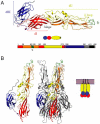Alphavirus Entry and Membrane Fusion
- PMID: 21546978
- PMCID: PMC3086016
- DOI: 10.3390/v2040796
Alphavirus Entry and Membrane Fusion
Abstract
The study of enveloped animal viruses has greatly advanced our understanding of the general properties of membrane fusion and of the specific pathways that viruses use to infect the host cell. The membrane fusion proteins of the alphaviruses and flaviviruses have many similarities in structure and function. As reviewed here, alphaviruses use receptor-mediated endocytic uptake and low pH-triggered membrane fusion to deliver their RNA genomes into the cytoplasm. Recent advances in understanding the biochemistry and structure of the alphavirus membrane fusion protein provide a clearer picture of this fusion reaction, including the protein's conformational changes during fusion and the identification of key domains. These insights into the alphavirus fusion mechanism suggest new areas for experimental investigation and potential inhibitor strategies for anti-viral therapy.
Figures


Similar articles
-
Role of TSPAN9 in Alphavirus Entry and Early Endosomes.J Virol. 2016 Apr 14;90(9):4289-97. doi: 10.1128/JVI.00018-16. Print 2016 May. J Virol. 2016. PMID: 26865714 Free PMC article.
-
Dealing with low pH: entry and exit of alphaviruses and flaviviruses.Trends Microbiol. 2009 Nov;17(11):514-21. doi: 10.1016/j.tim.2009.08.002. Epub 2009 Sep 30. Trends Microbiol. 2009. PMID: 19796949 Free PMC article. Review.
-
Fusion of a New World Alphavirus with Membrane Microdomains Involving Partially Reversible Conformational Changes in the Viral Spike Proteins.Biochemistry. 2017 Oct 31;56(43):5823-5830. doi: 10.1021/acs.biochem.7b00650. Epub 2017 Oct 18. Biochemistry. 2017. PMID: 28956592
-
Class II virus membrane fusion proteins.Virology. 2006 Jan 5;344(1):38-47. doi: 10.1016/j.virol.2005.09.036. Virology. 2006. PMID: 16364734 Review.
-
Alphavirus entry into host cells.Prog Mol Biol Transl Sci. 2015;129:33-62. doi: 10.1016/bs.pmbts.2014.10.002. Epub 2014 Dec 1. Prog Mol Biol Transl Sci. 2015. PMID: 25595800 Review.
Cited by
-
Residue-level resolution of alphavirus envelope protein interactions in pH-dependent fusion.Proc Natl Acad Sci U S A. 2015 Feb 17;112(7):2034-9. doi: 10.1073/pnas.1414190112. Epub 2015 Feb 2. Proc Natl Acad Sci U S A. 2015. PMID: 25646410 Free PMC article.
-
A key interaction between the alphavirus envelope proteins responsible for initial dimer dissociation during fusion.J Virol. 2013 Apr;87(7):3774-81. doi: 10.1128/JVI.03310-12. Epub 2013 Jan 16. J Virol. 2013. PMID: 23325694 Free PMC article.
-
Chikungunya virus entry is strongly inhibited by phospholipase A2 isolated from the venom of Crotalus durissus terrificus.Sci Rep. 2021 Apr 22;11(1):8717. doi: 10.1038/s41598-021-88039-4. Sci Rep. 2021. PMID: 33888774 Free PMC article.
-
Chikungunya Virus, Metabolism, and Circadian Rhythmicity Interplay in Phagocytic Cells.Metabolites. 2023 Nov 11;13(11):1143. doi: 10.3390/metabo13111143. Metabolites. 2023. PMID: 37999239 Free PMC article. Review.
-
Two Conserved Phenylalanine Residues in the E1 Fusion Loop of Alphaviruses Are Essential for Viral Infectivity.J Virol. 2022 May 11;96(9):e0006422. doi: 10.1128/jvi.00064-22. Epub 2022 Apr 13. J Virol. 2022. PMID: 35416719 Free PMC article.
References
Grants and funding
LinkOut - more resources
Full Text Sources
Other Literature Sources
Research Materials
